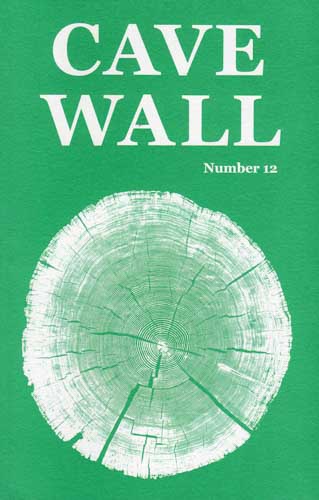Cave Wall – Fall 2013
The editor’s note in the latest issue of Cave Wall focuses heavily on the idea of time. The way it shifts all around us in an amorphous cloud, it seems that all we really have to hang onto is the moment right in front of us, to the beauty or pain of each experience as it happens. Memory, growth, and understanding come into play throughout, making for a quick read that’s both relatable and stirring.
The editor’s note in the latest issue of Cave Wall focuses heavily on the idea of time. The way it shifts all around us in an amorphous cloud, it seems that all we really have to hang onto is the moment right in front of us, to the beauty or pain of each experience as it happens. Memory, growth, and understanding come into play throughout, making for a quick read that’s both relatable and stirring.
Nathaniel Perry’s “In Bloom, Where the Meadow Rises” and “In the Briar Where a Hundred Sparrows Stop” start out the collection, both beginning with the question “Do you remember . . .” and addressing a child who is presumably the speaker’s daughter. The first piece especially stresses the importance of memory’s role in our lives. While it was only the girl’s “fifth day in the world,” it’s nearly impossible for her to keep it in mind, her father promises that the image can have power.
if you can find that evening, which is stationed
in my chest, inside you now, I swear it will
get you somewhere, across a field so filled
with snow the sky and ground are one, across
a field so bleached with drought the giant cross
of shadows from the pines is friction enough
to set the day on fire. . . .
Adam Houle’s “We’d Learn Later Her Husband Left” is centered on a memory as well, with the speaker discussing one of their childhood Quaker teachers. Here, the act of remembering is used as a means of interpretation, a way to contextualize a past feeling and reconcile anger with a peaceful religion. The speaker wanted to know “whom [he] could hurt to stop her hurt, / sure that some violence God could endorse, / that mercy’s counterweight is just and swift.” And Joanna Pearson’s “Prosopagnosia” sees memory turning against us; its title means “face blindness” and in the first lines, the speaker asks “what devotion then could recognize / the lover even when his face belies / his very face?”
In Alison Pelegrin’s “Saved,” the speaker’s easy pace implies an almost matter of fact response to the idea of Christianity, that its showiness is not for her:
I’ve seen them on the road
doing an angel Horsemen of the Apocalypse routine
at the prison rodeo—white boots, white fringe
on their sleeves, beating stallions with braided manes
to their knees, snuffing the shine in their eyes
so nothing’s left but beast. What creature am I?
This impressive image serves as a metaphor for the submission necessary in any religion and is made even stronger by the speaker’s definitive final statement, “There’s no breaking me of curses.”
Karen Skolfield’s “How Strange Might Life Be” is a beautiful exploration of a complicated and tense mother/daughter relationship, using the poet’s own name as a jumping off point. Skolfield artfully weaves together ideas of language and conception, calling into question the very start of a thing’s life. She points out that “the name Cain has never recovered, which makes sense, / nor Abel, which makes less sense except that we want // our children to be immortal” and later addresses herself to say “Karen Diane, // your mother was upset because somehow you’d / grown legs and walked away . . .”
A number of Bryan Nash Gill’s woodcut prints are interspersed throughout Cave Wall, their somehow simultaneously intricate and simple patterns perfectly matching the overall tone of the issue. And while it may be slim, the weight of the pieces inside is undeniable.
[www.cavewallpress.com]





